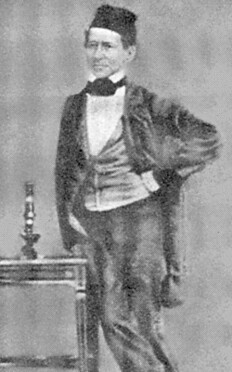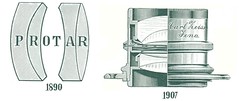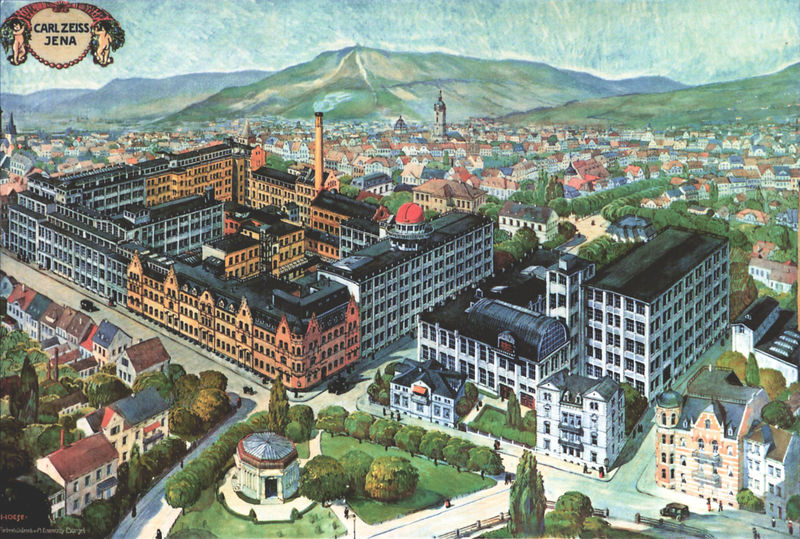(→Links) |
Rebollo fr (talk | contribs) (→Various: one more Japanese ad) |
||
| Line 98: | Line 98: | ||
|- |
|- |
||
| colspan="2" | ''Advertisements by Carl Zeiss K.K. in ''[[Asahi Camera]]'' February 1930 (left) and June 1932 (right). {{public domain Japan old}}'' |
| colspan="2" | ''Advertisements by Carl Zeiss K.K. in ''[[Asahi Camera]]'' February 1930 (left) and June 1932 (right). {{public domain Japan old}}'' |
||
| + | |- |
||
| + | | colspan="2" | [http://www.flickr.com/photos/rebollo_fr/2611630872/in/pool-camerapedia/ http://farm4.static.flickr.com/3167/2611630872_58d1da21c9_d.jpg] |
||
| + | |- |
||
| + | | colspan="2" | ''Advertisement by Carl Zeiss K.K. in the supplement to ''[[Camera Club]]'' October 1936. {{public domain Japan old}}'' |
||
|} |
|} |
||
Revision as of 23:13, 14 July 2008
The optics

|
| Carl Zeiss at the age of 47 (Image rights) |
Carl Zeiss of Germany is among the most renowned of the lens manufacturers. It's part of the Carl Zeiss Foundation, which also owned the Zeiss Ikon camera maker from its foundation in 1926 until it disappeared in 1972. In its long history it equipped many camera makers.
The company was founded in Jena in 1856 and called Carl Zeiss Jena. It created such classic lens formulae as the Tessar, Planar, Biogon, and Sonnar. Around 1900 Zeiss lenses were licensed by Bausch & Lomb (Rochester), F. Koritska (Milano), E. Krauss (Paris) and Ross (London). In 1902 it bought the camera maker Palmos A.G. and continued it as Carl Zeiss Palmos. In 1909 the camera making daughter company was merged into the ICA group which later became part of Zeiss-Ikon.
After World War II, Jena being in the Eastern part of Germany, the company split in two. One part was recreated in West Germany and based in Oberkochen, and kept within the Zeiss Foundation. The other part remained in Jena, but soon lost the right to use the traditional names, like Zeiss and the other famous lens names. In the Western countries it was known as aus Jena (means from Jena), and used obvious abreviations, or other names reminding the past (for ex. T for Tessar, S for Sonnar). In the countries of the Eastern block, they continued to use the full names.
Carl Zeiss Oberkochen made lenses for the Western Zeiss Ikon after the war, but they have also made dedicated lenses for other camera marques. They continue to do so, notably for Rollei and Hasselblad. The Zeiss lenses for the Hasselblad series of medium format SLR cameras are known for their high quality, precision tolerances, resolution, and color rendition, and have been used by many well-known photographers.
From 1973, Carl Zeiss made a range of lenses with a bayonet mount for Yashica and Contax 35mm SLR cameras, in partnership with Yashica Camera Co. Ltd. The resulting Zeiss T* lenses were made both in Germany and under license in Japan, and developed a reputation for superb optical quality. Kyocera, which acquired Yashica, later partnered with Zeiss to introduce still other Zeiss T* lenses, including rangefinder and autofocus-mount models. In 2005, Kyocera ceased all camera production and discontinued the marketing of Carl Zeiss lenses.
Very recently the Carl Zeiss foundation has revived the Zeiss Ikon name for a new type of rangefinder camera, with lenses designed by Carl Zeiss and manufactured by Cosina in Japan. Sony uses Zeiss lenses for its digital cameras.
Some trademarks used by Carl Zeiss
| Zeiss Super Tele Lens 4/1700 |
|---|
|
In 2006 Zeiss is working on a new super tele lens for Hasselblad medium format cameras. It was ordered by the Emirate of Katar and will be delivered in 2007. It consists of 15 lens elements in 13 groups and weighs 256 kg. It will be used to make pictures of fast animals in natural environment, especially the Qatari heraldic animal, the Oryx antelope. It's the biggest tele lens ever made for non-military purposes. |
- Hologon
- Biogon
- Biometar (East only)
- Biotar
- Distagon (West only)
- Flektogon (East only)
- Flexon (East only)
- Pancolar (East only)
- Planar

|
| Tessar |
- Protar
- Sonnar
- Tessar
- Topogon
- Triotar
Lenses marked Novar were three element lenses, as others used for the Zeiss Ikon camera brand it's sometimes mistaken as a Carl Zeiss lens.
The Zeiss lenses of the Icarex had the names Ultron, Skoparex and Dynarex, that were originally Voigtländer trademarks.
See also
| historic lens Zeiss Protar |
|---|

|
|
In 1889 Zeiss could introduce the Anastigmat of its scientist Paul Rudolph. It was the first lens with corrected astigmatism. In 1890 it was renamed to Protar. |
The links go directly to the Zeiss section:
- 39mm screw lenses
- 42mm screw lenses
- Contax rangefinder lenses
- Exakta lenses
- Praktina lenses
- Praktiflex lenses
- Rolleiflex SL35 lenses
- Yashica / Contax lenses
- Contax SLR Pages
Cameras with a fixed Carl Zeiss lens
The cameras
The Carl Zeiss Palmos
See Carl Zeiss Palmos.
The Jena Contax
See Contax rangefinder.
The Werra
See Werra.
Various
Carl Zeiss lenses and ICA cameras were imported in Japan in the 1920s by the subsidiary company Carl Zeiss Gōshi-gaisha (カールツァイス合資会社). It became Carl Zeiss K.K. (カールツァイス㈱) at some time, and imported the Zeiss Ikon cameras in the 1930s.

| |
| Advertisement by Carl Zeiss Gōshi-gaisha in Ars Camera April 1922. (Image rights) | |

|

|
| Advertisements by Carl Zeiss K.K. in Asahi Camera February 1930 (left) and June 1932 (right). (Image rights) | |

| |
| Advertisement by Carl Zeiss K.K. in the supplement to Camera Club October 1936. (Image rights) | |
Bibliography
- Ars Camera. Advertisement by Carl Zeiss in April 1922. No page number.
- Asahi Camera. Advertisements by Carl Zeiss in February 1930 (p.A6) and June 1932 (p.A6).
Links
- Carl Zeiss - a history of the most respected name in optics
- Carl Zeiss Jena Gallery at Manual Focus Lenses
- Carl Zeiss Lens Design by Alexander Lee
- Carl Zeiss page at Collection G. Even's site
- Cameras at www.collection-appareils.fr

|
| Carl Zeiss Werk in Jena around 1910 (Image rights) |